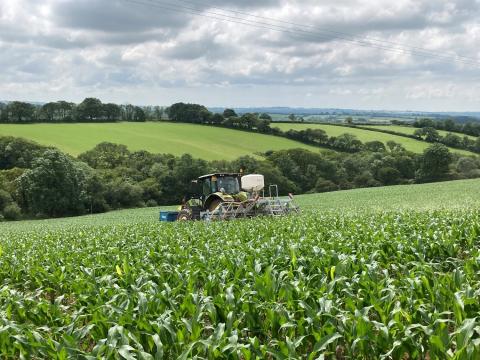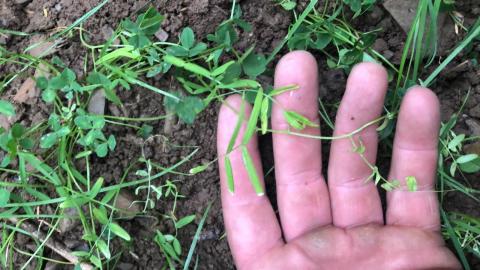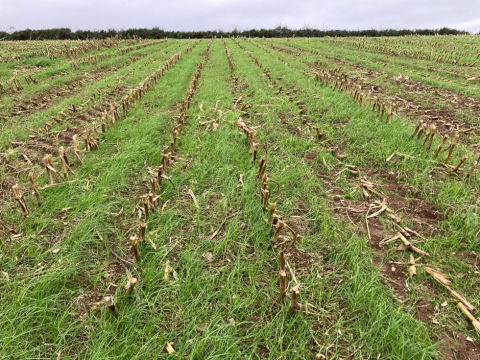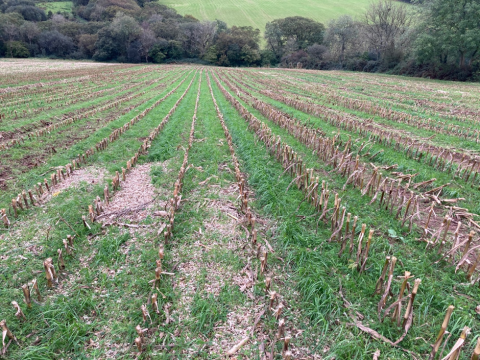Arnolds Hill Farm Final Project Report: Undersowing maize for environmental and economic benefit
Site: Arnolds Hill Farm, Slebech, Haverfordwest
Technical Officer: Delana Davies
Project Title: Undersowing maize for environmental and economic benefit
Introduction to project
Climate change is delivering more winter heavy rainfall incidences that river monitoring has indicated is accompanied by spikes in river phosphate levels, which has been attributed to soil runoff. Leaving maize stubbles bare over winter is therefore not sustainable, but planning to establish a crop or cover after maize harvest can be problematic because of autumn soil conditions and late sowing.
In Denmark, thousands of hectares of maize are now undersown with grass seed, and extensive trial work there has provided guidelines to ensuring good establishment.
What are the benefits?
- Reduces soil erosion
- Builds fertility
- Builds organic matter
- Retains soil nutrients (+/- 40kg/ha N + K)
- Enhances soil structure
- Easier preparation of spring seedbeds
- Cross-compliance good practice
- Provides winter/spring grazing opportunity
Establishing the undersown cover crop
The target period for sowing cover crops into maize is from one week after the last herbicide is applied through to the stage when the crop is thigh-high in early July. The maize crop should be between the four-leaf and 10-leaf stage.
Early work involved either broadcasting the grass seed onto the ground, or broadcasting and harrowing it in with a wire-tined rake; this can be effective when rain follows, but is much less reliable when dry. Initial drilling work was carried out using a modified drill to deliver grass strips between the rows of maize, but purpose-built drills are now being manufactured.
Danish trials suggested that establishment is enhanced by drilling the grass seed and consolidating behind the drill. This improves reliability and allows use of lower seed rates.
To avoid the undersown crop competing with the maize, it cannot be sown until the maize is well established, but it must be done while the maize is still short enough to drive through. There is also a risk of herbicides affecting the establishing cover crop, and the advice is to work closely with your agronomist to determine the best strategy for your circumstances.
Undersown seed options
Trials in the Welsh border area have used Italian (IRG) and Perennial (PRG) ryegrasses. IRG are the most vigorous, and have the potential to produce optimum biomass yield after the maize has been harvested. Being less vigorous, PRG is potentially better suited to earlier sowing; because of the higher number of seeds/kg, it can be sown at extremely low seed rates.
In Denmark, they have also trialled cocksfoot and tall fescue, which were much slower to establish, but provided adequate ground cover through the winter; chicory was also found to be vigorous and deep-rooting. Mixtures of vetches and IRG plus berseem clover and IRG have also been used; both these options also fix additional nitrogen for the following crop and potentially boost early spring growth.
It is not advisable to harvest the cover crop for silage the following spring, because the soil surface can be uneven following maize harvesting operations creating the risk of soil contamination. The field will also have significant quantities of maize stalks unless these are flailed off immediately after harvest. Winter or early spring grazing with sheep or young cattle is most appropriate.
What was done
A 5ha field situated on a slope and sown with Augustus maize was chosen as being likely to suffer from soil erosion if left uncropped over winter.
Four trial plot areas were established by undersowing into the standing maize crop on 2 July using a Zocon tine drill:
Plot 1 – Italian ryegrass (IRG) blend sown at 7kg/ac (17.3kg/ha). IRG is vigorous and economical to use as a short rotation crop. Using diploid varieties will mean a high seed rate with plenty of plants, and varieties were selected to maximise yield by April.
Plot 2 - Straight tetraploid Perennial ryegrass sown at 8kg/ac (19.8kg/ha). This has the potential to graze better quality grass if left through to the next season (leafier and will head later). It will last longer than IRG, and this trial will investigate how well it competes under the maize canopy.
Plot 3 - Italian ryegrass and winter vetch sown at 12kg/ac (29.6kg/ha). The addition of vetch increases the protein content of the grazed material and will start fixing nitrogen for the following crop; its extensive rooting system also benefits soil structure.
Plot 4 – IRG and Berseem clover sown at 8kg/ac (19.8kg/ha). This addition of berseem clover provides for rapid biomass cover and the ability to quickly fix nitrogen. The protein quality of the sward is also boosted by the clover. Although this clover is not very frost-tolerant, this can represent a bonus when direct drilling the following spring crop, as most of the canopy will be gone by this time.
Drilling the cover crop plots 2 July
Grass establishment 30 July
IRG and vetch plot with volunteer clover 30 July
Harvesting
The maize was harvested on 16 October, at the end of a dry week. There were only very minimal wheeling imprints left by harvesting machinery, resulting in no visible water run-off tracks following 25mm rainfall on 17 October.
20 October
20 October
20 October IRG and vetch
Plot performance
The grass plots yielded an average of 2.5-3.0 tonnes DM/ha, with the two plots based on IRG providing the highest covers. As anticipated, the plot incorporating the berseem clover appeared to be negatively affected by the maize herbicide.
There was no apparent impact on maize yield from undersowing, with the crop of Augustus maize averaging 43 t/ha (17t/acre), similar to previous years when the crop was not undersown.
It is also likely that the undersown sward helps to retain nitrogen in the soil for the next crop, to the extent of up to 40kg/ha. Incorporating vetch would add to this, with the establishment of nitrogen-fixing nodules on the plant roots acting as a reservoir for the next crop.
Winter grazing
Ewe lambs being wintered on tack were turned into the trial field in December, and 160 lambs were grazed for 17 days, followed by another seven days in February. In April, the field supported grazing for another 70 store lambs for 20 days, and 12 cattle were turned in to clear the field.
Undersowing costs and grazing returns
Grass seed (Italian ryegrass option) 5ha @ £50/ha = £250
Drilling grass seed 5ha @ £37/ha = £185
Total undersowing costs = £435
Total sheep grazing days achieved = 5,240
Return from tack grazing (90p/head /week) = £674
Conclusions
Undersowing grass seed into a standing maize crop resulted in complete ground cover by the time of harvest and prevented any surface soil runoff during the winter period.
The cost of the grass seed and drilling at £87/ha were well covered by achieving 1,048 sheep grazing days per hectare valued at £135 from the resulting sward.
All treatment plots performed well, but the treatment of choice for this farm moving forward to support winter tack sheep grazing is likely to be the IRG blend, which produces the greatest dry matter output potential for the period from November to April.






